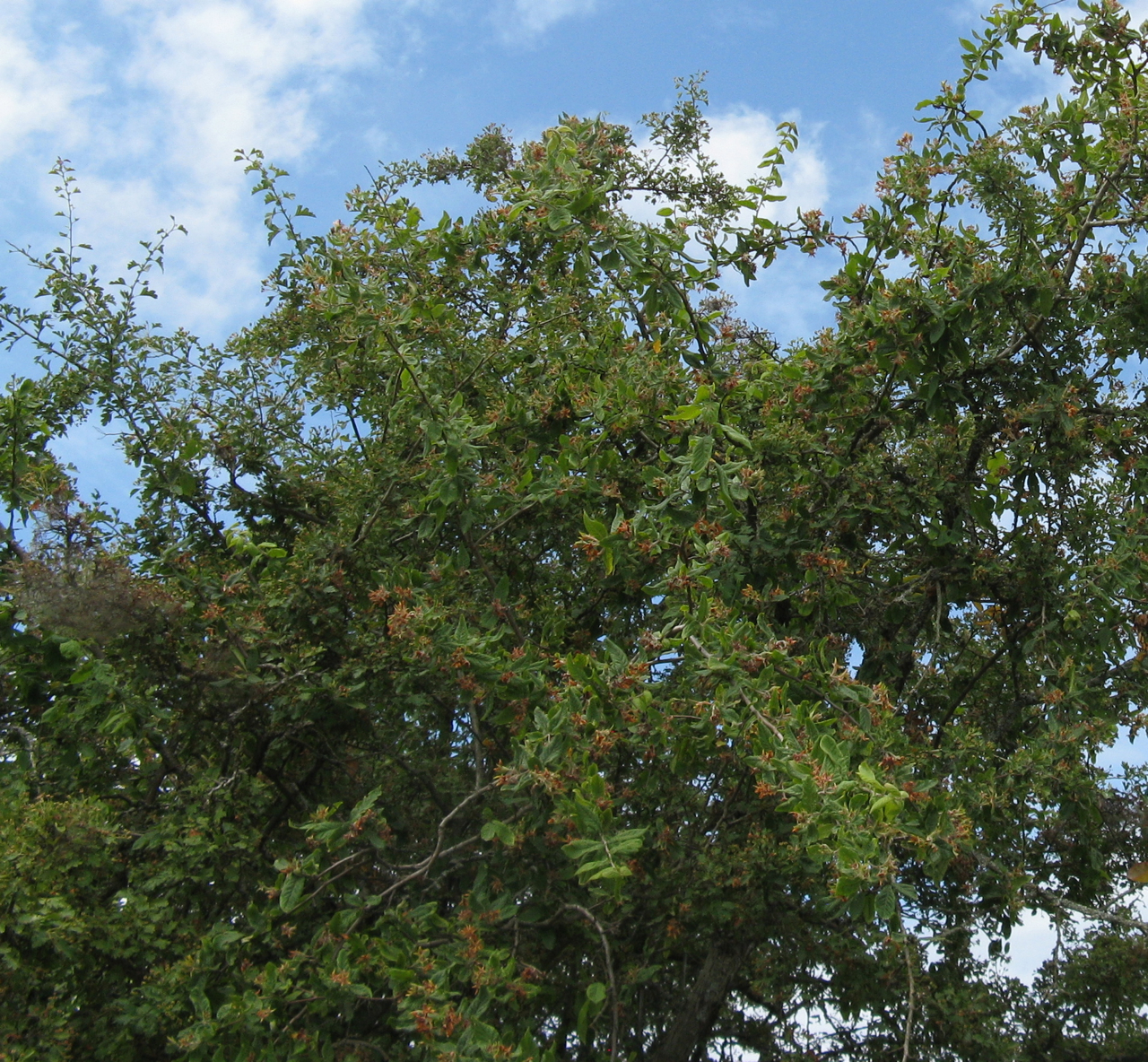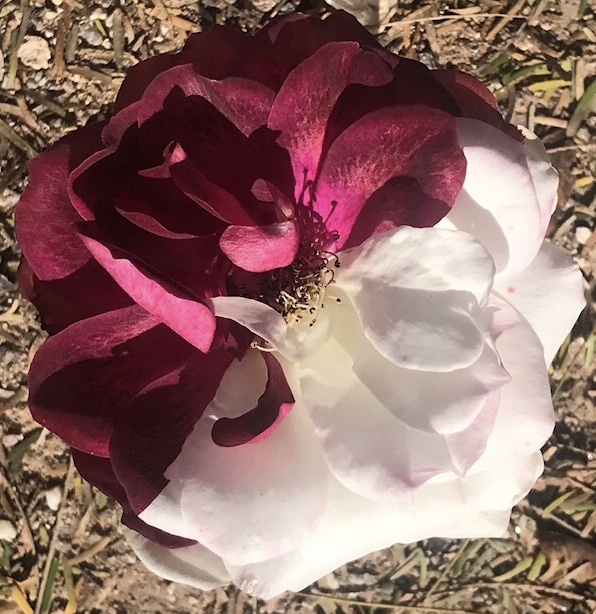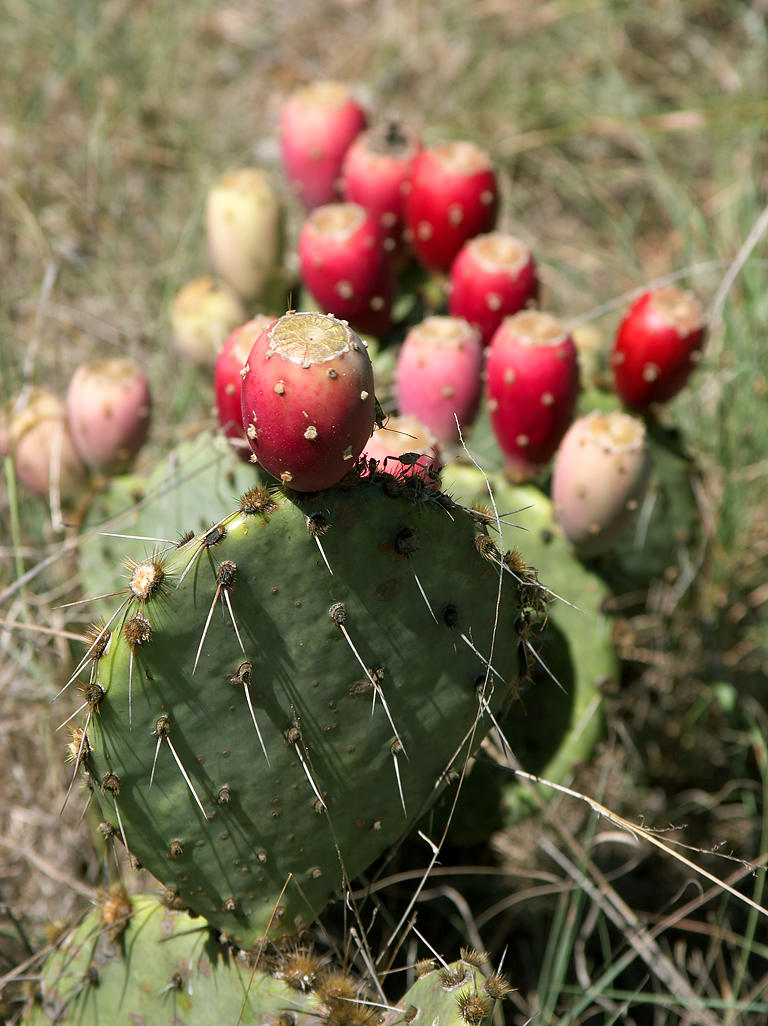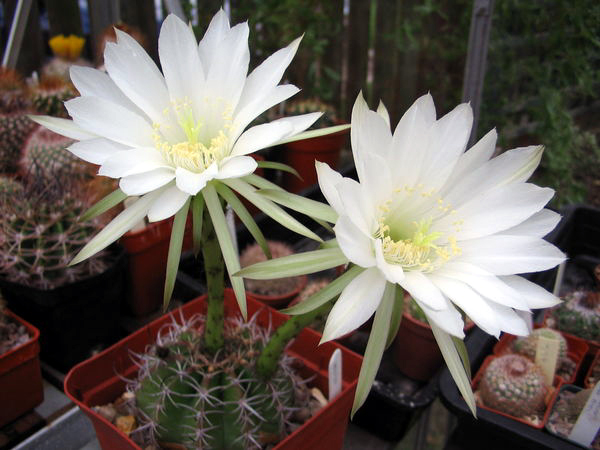|
Graft-chimera
In horticulture, a graft-chimaera may arise in grafting at the point of contact between rootstock and scion and will have properties intermediate between those of its "parents". Unlike graft hybrids, a graft-chimaera is not a true hybrid but a mixture of cells, each with the genotype of one of its "parents": it is a chimaera. Hence, the once widely used term "graft-hybrid" is inaccurate for a graft-chimaera. Propagation is by cloning only. In practice graft-chimaeras are not noted for their stability and may easily revert to one of the "parents". Nomenclature Article 21 of the ''ICNCP'' stipulates that a graft-chimaera can be indicated either by * a formula: the names of both "parents", in alphabetical order, joined by the plus sign "+": : ''Crataegus'' + ''Mespilus'' * a name: ** if the "parents" belong to different genera a name may be formed by joining part of one generic name to the whole of the other generic name. This name must not be identical to a generic name published ... [...More Info...] [...Related Items...] OR: [Wikipedia] [Google] [Baidu] |
+Laburnocytisus Wideangle
+'' Laburnocytisus'' 'Adamii' (also known as Adam's laburnum or broom laburnum) is a horticulture, horticultural curiosity; a small tree which is a graft-chimaera between two species, a laburnum, ''Laburnum anagyroides'', and a broom (shrub), broom, ''Chamaecytisus purpureus'' (synonym (taxonomy), syn. ''Cytisus purpureus''), which bears some shoots typical of the one species, some of the other, and some which are a peculiar mixture of both "parents". The plus sign (+) indicates the generic name is made for a graft-chimaera. The plant can also be described by the formula ''Laburnum anagyroides'' + ''Chamaecytisus purpureus''. + ''Laburnocytisus'' 'Adamii' is a legume, a member of the pea family Faboideae (or Papilionaceae, formerly Leguminosae). Only one cultivar, 'Adamii' is known to have arisen from this graft. It is sometimes described as if it were one species, (+ )''Laburnocytisus adamii''; however, it is not one species and this notation is not conf ... [...More Info...] [...Related Items...] OR: [Wikipedia] [Google] [Baidu] |
Cultivar
A cultivar is a kind of Horticulture, cultivated plant that people have selected for desired phenotypic trait, traits and which retains those traits when Plant propagation, propagated. Methods used to propagate cultivars include division, root and stem cuttings, offsets, grafting, micropropagation, tissue culture, or carefully controlled seed production. Most cultivars arise from deliberate human genetic engineering, manipulation, but some originate from wild plants that have distinctive characteristics. Cultivar names are chosen according to rules of the International Code of Nomenclature for Cultivated Plants (ICNCP), and not all cultivated plants qualify as cultivars. Horticulturists generally believe the word ''cultivar''''Cultivar'' () has two meanings, as explained in ''#Formal definition, Formal definition'': it is a classification category and a taxonomic unit within the category. When referring to a taxon, the word does not apply to an individual plant but to all plants t ... [...More Info...] [...Related Items...] OR: [Wikipedia] [Google] [Baidu] |
+ Crataegomespilus
+ ''Crataegomespilus'' is the generic name applied to graft-chimeras between the genera ''Crataegus'' and ''Mespilus''. It should not be confused with × Crataemespilus, × ''Crataemespilus'', which is applied to sexual hybrids between those genera, nor with ''Chamaemespilus'' which is a Segregate (taxonomy), segregate genus or subgenus of ''Sorbus''. References External links * Maleae Graft chimeras {{maleae-stub ... [...More Info...] [...Related Items...] OR: [Wikipedia] [Google] [Baidu] |
Chimera (plant)
A genetic chimerism or chimera ( or ) is a single organism composed of cells of different genotypes. Animal chimeras can be produced by the fusion of two (or more) embryos. In plants and some animal chimeras, mosaicism involves distinct types of tissue that originated from the same zygote but differ due to mutation during ordinary cell division. Normally, genetic chimerism is not visible on casual inspection; however, it has been detected in the course of proving parentage. More practically, in agronomy, "chimera" indicates a plant or portion of a plant whose tissues are made up of two or more types of cells with different genetic makeup; it can derive from a bud mutation or, more rarely, at the grafting point, from the concrescence of cells of the two bionts; in this case it is commonly referred to as a "graft hybrid", although it is not a hybrid in the genetic sense of "hybrid". In contrast, an individual where each cell contains genetic material from two organisms of dif ... [...More Info...] [...Related Items...] OR: [Wikipedia] [Google] [Baidu] |
Echinocactus
''Echinocactus'' is a genus of cacti in the subfamily Cactoideae. The generic name derives from the Ancient Greek Ancient Greek (, ; ) includes the forms of the Greek language used in ancient Greece and the classical antiquity, ancient world from around 1500 BC to 300 BC. It is often roughly divided into the following periods: Mycenaean Greek (), Greek ... ἐχῖνος (''echînos''), meaning "spiny," and ''cactus''. It and '' Ferocactus'' are the two genera of barrel cactus. Members of the genus usually have heavy spination and relatively small flowers. The fruits are copiously woolly, and this is one major distinction between ''Echinocactus'' and ''Ferocactus''. Propagation is by seed. Species As of 2025, the genus includes 3 accepted species out of hundreds of plants having the name. Formerly placed here *'' Astrophytum asterias'' (Zucc.) Lem. (as ''E. asterias'' Zucc.) *'' Aztekium ritteri'' (Boed.) Boed. (as ''E. ritteri'' Boed.) *'' Kroenleinia grusonii'' ... [...More Info...] [...Related Items...] OR: [Wikipedia] [Google] [Baidu] |
Astrophytum
''Astrophytum'' is a genus of six species of cacti, native to North America. These species are sometimes referred to as living rocks, though the term is also used for other genera, particularly '' Lithops'' (Aizoaceae). The generic name is derived from the Greek words άστρον (''astron''), meaning "star," and φυτόν (''phyton''), meaning "plant." Description The species of the genus ''Astrophytum'' usually grow individually with spherical to columnar green shoots and reach heights of up to 1.5 meters. The shoots are often densely covered with fine white tufts of hair, but sometimes they are completely bald. There are 4–10 (rarely 3) very noticeable ribs that are not divided into cusps. The large areoles stand close together, but do not merge. The spike is variable. Spines may be present or may be missing entirely. The funnel-shaped, large flowers are yellow or yellow with a red throat. They appear at the top of the shoots and open during the day. The pericarpel is ... [...More Info...] [...Related Items...] OR: [Wikipedia] [Google] [Baidu] |
+ Echinastrophytum
The plus sign () and the minus sign () are mathematical symbols used to denote positive and negative functions, respectively. In addition, the symbol represents the operation of addition, which results in a sum, while the symbol represents subtraction, resulting in a difference. Their use has been extended to many other meanings, more or less analogous. and are Latin terms meaning 'more' and 'less', respectively. The forms and are used in many countries around the world. Other designs include for plus and for minus. History Though the signs now seem as familiar as the alphabet or the Arabic numerals, they are not of great antiquity. The Egyptian hieroglyphic sign for addition, for example, resembles a pair of legs walking in the direction in which the text was written (Egyptian could be written either from right to left or left to right), with the reverse sign indicating subtraction: Nicole Oresme's manuscripts from the 14th century show what may be one of the ea ... [...More Info...] [...Related Items...] OR: [Wikipedia] [Google] [Baidu] |
Opuntia
''Opuntia'', commonly called the prickly pear cactus, is a genus of flowering plants in the cactus family Cactaceae, many known for their flavorful fruit and showy flowers. Cacti are native to the Americas, and are well adapted to arid climates; however, they are still vulnerable to alterations in precipitation and temperature driven by climate change. The plant has been introduced to parts of Australia, southern Europe, the Middle East, and northern Africa. ''Prickly pear'' alone is more commonly used to refer exclusively to the fruit, but may also be used for the plant itself; in addition, other names given to the plant and its specific parts include ''tuna'' (fruit), ''sabra'', ''sabbar'', '' nopal'' (pads, plural ''nopales'') from the Nahuatl word , nostle (fruit) from the Nahuatl word , and paddle cactus. The genus is named for the Ancient Greek city of Opus. The fruit and leaves are edible. The most common culinary species is the "Barbary fig" ('' Opuntia ficus-indica ... [...More Info...] [...Related Items...] OR: [Wikipedia] [Google] [Baidu] |
+ Echinogymnocalycium
The plus sign () and the minus sign () are mathematical symbols used to denote positive and negative functions, respectively. In addition, the symbol represents the operation of addition, which results in a sum, while the symbol represents subtraction, resulting in a difference. Their use has been extended to many other meanings, more or less analogous. and are Latin terms meaning 'more' and 'less', respectively. The forms and are used in many countries around the world. Other designs include for plus and for minus. History Though the signs now seem as familiar as the alphabet or the Arabic numerals, they are not of great antiquity. The Egyptian hieroglyphic sign for addition, for example, resembles a pair of legs walking in the direction in which the text was written (Egyptian could be written either from right to left or left to right), with the reverse sign indicating subtraction: Nicole Oresme's manuscripts from the 14th century show what may be one of the ea ... [...More Info...] [...Related Items...] OR: [Wikipedia] [Google] [Baidu] |
Coryphantha
''Coryphantha'' (from Greek, "flowering on the top"), or beehive cactus, is a genus of small to middle-sized, globose or columnar cacti. The genus is native to arid parts of Central America, Mexico, through Arizona, New Mexico, and western Texas and north into southwestern, central, and southeastern Montana. With its two subgenera, 57 species and 20 subspecies, it is one of the largest genera of cactus.Dicht, Reto F. and Lüthy, Adrian D. (2005) ''Coryphantha: Cacti of Mexico and Southern USA''. Springer, Berlin, p. 1, Description There are four characteristics that distinguish ''Coryphantha'' from other cacti. # Their bodies do not have ribs, just tubercles.Dicht, Reto F. and Lüthy, Adrian D. (2005) "3.2 Tubercles" ''Coryphantha: Cacti of Mexico and Southern USA''. Springer, Berlin, pp. 9–12, # The flowers form at the top of the plant (the apex or growing end of the stem). # The tip ( podarium) of each flowering tubercle has three parts, the spiny areole, the groove and the ... [...More Info...] [...Related Items...] OR: [Wikipedia] [Google] [Baidu] |
+ Coryopuntia
The plus sign () and the minus sign () are mathematical symbols used to denote positive and negative functions, respectively. In addition, the symbol represents the operation of addition, which results in a sum, while the symbol represents subtraction, resulting in a difference. Their use has been extended to many other meanings, more or less analogous. and are Latin terms meaning 'more' and 'less', respectively. The forms and are used in many countries around the world. Other designs include for plus and for minus. History Though the signs now seem as familiar as the alphabet or the Arabic numerals, they are not of great antiquity. The Egyptian hieroglyphic sign for addition, for example, resembles a pair of legs walking in the direction in which the text was written (Egyptian could be written either from right to left or left to right), with the reverse sign indicating subtraction: Nicole Oresme's manuscripts from the 14th century show what may be one of the ea ... [...More Info...] [...Related Items...] OR: [Wikipedia] [Google] [Baidu] |
Echinopsis
''Echinopsis'' is a genus of Cactus, cacti native plant, native to South America, sometimes known as hedgehog cactus, sea-urchin cactus or Easter lily cactus. , there are about 20 accepted species, ranging from large and treelike types to small globose cacti. The name derives from ''echinos'' hedgehog or sea urchin, and ''opsis'' appearance, a reference to these plants' dense coverings of spines. They are remarkable for the great size, length of tube, and beauty of their flowers, borne upon generally small and dumpy stems. Taxonomy Studies in the 1970s and 1980s resulted in several formerly separate genera being absorbed into ''Echinopsis''. When very broadly Circumscription (taxonomy), circumscribed, ''Echinopsis'' Sensu, sensu lato included over 100 species. Some genera have been absorbed and then accepted again. For example, the genus name ''Trichocereus'' was given to a number of columnar cacti in 1909 by Vincenzo Riccobono. The genus was subsumed into ''Echinopsis'' in 1 ... [...More Info...] [...Related Items...] OR: [Wikipedia] [Google] [Baidu] |







